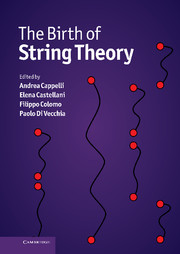Book contents
- Frontmatter
- Contents
- List of contributors
- Photographs of contributors
- Preface
- Abbreviations and acronyms
- Part I Overview
- 1 Introduction and synopsis
- 2 Rise and fall of the hadronic string
- 3 Gravity, unification, and the superstring
- 4 Early string theory as a challenging case study for philosophers
- EARLY STRING THEORY
- Part II The prehistory: the analytic S-matrix
- Part III The Dual Resonance Model
- Part IV The string
- TOWARDS MODERN STRING THEORY
- Part V Beyond the bosonic string
- Part VI The superstring
- Part VII Preparing the string renaissance
- Appendix A Theoretical tools of the Sixties
- Appendix B The Veneziano amplitude
- Appendix C From the string action to the Dual Resonance Model
- Appendix D World-sheet and target-space supersymmetry
- Appendix E The field theory limit
- Index
4 - Early string theory as a challenging case study for philosophers
from Part I - Overview
Published online by Cambridge University Press: 05 May 2012
- Frontmatter
- Contents
- List of contributors
- Photographs of contributors
- Preface
- Abbreviations and acronyms
- Part I Overview
- 1 Introduction and synopsis
- 2 Rise and fall of the hadronic string
- 3 Gravity, unification, and the superstring
- 4 Early string theory as a challenging case study for philosophers
- EARLY STRING THEORY
- Part II The prehistory: the analytic S-matrix
- Part III The Dual Resonance Model
- Part IV The string
- TOWARDS MODERN STRING THEORY
- Part V Beyond the bosonic string
- Part VI The superstring
- Part VII Preparing the string renaissance
- Appendix A Theoretical tools of the Sixties
- Appendix B The Veneziano amplitude
- Appendix C From the string action to the Dual Resonance Model
- Appendix D World-sheet and target-space supersymmetry
- Appendix E The field theory limit
- Index
Summary
Introduction
The history of the origins and first developments of string theory, from Veneziano's formulation of his famous scattering amplitude in 1968 to the so-called first string revolution in 1984, provides invaluable material for philosophical reflection. The reasons why this episode in the history of modern physics – one still largely unknown to the philosophy of science community despite its centrality to theoretical physics – represents a particularly interesting case study are several and various in nature. It is the aim of the present Chapter to illustrate some of them.
In general, the story of the construction of a new scientific theory is of evident interest in itself, as a concrete example of how a particular theory has been discovered and developed by a given community and over a certain period of time. On the other hand, case studies taken from the history of science are commonly used, by those philosophers of science who pay attention to actual scientific practice, to provide some evidence for or against given positions on traditional epistemological or methodological issues. In other words, with respect to philosophical ‘theories’ on given aspects of the scientific enterprise, historical case studies are attributed a role analogous to that of the data of experience in scientific theories. These aspects can be of a very general character, such as those regarding the methodology, aim and evaluation of scientific theories; or they can be of a more specific kind, such as the significance of a certain principle, argument or concept.
- Type
- Chapter
- Information
- The Birth of String Theory , pp. 63 - 78Publisher: Cambridge University PressPrint publication year: 2012
- 2
- Cited by

